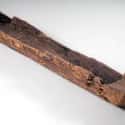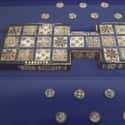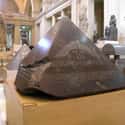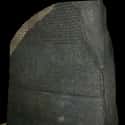-
(#7) The Pesse Canoe (c. 8000 BC)
Believed to be the oldest-known boat in the world, and certainly the oldest canoe in the historical record, the Pesse canoe was discovered in Pesse, a village in the Dutch province of Drenthe, during the construction of a highway. The boat was carved out of a pine log roughly 10,000 years ago.
Carbon dating has placed the canoe's construction to the Mesolithic period, between 8040 BC and 7510 BC. A similar boat was discovered outside a village in Nigeria, dated some 2,000 years later.
-
(#10) British Museum Royal Game of Ur (c. 2600-2400 BC)
Popular throughout the Mediterranean and the Middle East thousands of years ago, the Royal Game of Ur was a popular pastime for ancient peoples.
As Irving Finkel, the assistant keeper at London's British Museum in the Department of the Middle East, explains, "There were no entertainments for such a huge period of human existence. In that environment, games had a fantastically strong hold. They reigned supreme."
Time sums it up even better: "For centuries, even millenniums, the Royal Game of Ur served as the PlayStation of its day."
-
(#12) A Jade Cong From The Liangzhu Culture (c. 3300-2200 BC)
Living in China's Jiangsu province in the third millennium BC, the Neolithic Liangzhu culture created items out of jade, ceramic, and stone that still exist today. Many "cong" objects have been found, exhibiting a circular inner shape and square outer section, but their use and significance remain mysterious. Several cong have been unearthed in Chinese tombs from the period.
Khan Academy describes these objects as "among the most impressive yet most enigmatic of all ancient Chinese jade artifacts." Also, they "were extremely difficult and time-consuming to produce. As jade cannot be split like other stones, it must be worked with a hard abrasive sand."
-
(#4) The Pyramidion Of The Black Pyramid Of Dashur (c. 1820 BC)
Pyramidions were created to be the capstones of ancient Egytpian pyramids, and few have survived into the present day. This pyramidion was found in the rubble near the Pyramid of Amenemhat III at Dashur, which is sometimes referred to as the Black Pyramid.
Not much remains of the Black Pyramid today, due to poor construction methods that doomed the structure from the beginning. The granite pryamidion, however, is in relatively good shape, and its four sides still bear legible inscriptions. It is currently housed in the Egyptian Museum at Cairo.
-
(#5) Babylonian Map Of The World (c. Sixth Century BC)
This clay tablet, dated to approximately 700 BC, depicts the world as a disc surrounded by a ring of water called the "Bitter River." Small circles indicate cities or districts, including Assyria and Der, and the rectangle on the right side of the Euphrates River is Babylon itself.
The British Museum has more information on the tablet, including details on the reverse side that describes eight regions beyond the known world, including the underworld.
-
(#1) Rosetta Stone
- Relief
This giant slab of basalt is where the Rosetta Stone language-learning program gets its name. Discovered by Napoleon Bonaparte's army in 1799, the slab contains a decree from King Ptolemy V (r. 204-181 BC) written in three different languages: Egyptian hieroglyphic, Egyptian Demotic (the "language of the people"), and ancient Greek (the language of Egypt's Greco-Macedonian rulers).
As the British Museum explains:
The importance of [the Rosetta Stone] to Egyptology is immense. When it was discovered, nobody knew how to read ancient Egyptian hieroglyphs. Because the inscriptions say the same thing in three different scripts, and scholars could still read Ancient Greek, the Rosetta Stone became a valuable key to deciphering the hieroglyphs.
New Random Displays Display All By Ranking
About This Tool
While ancient times happened so long ago, some things never change. Over the years, archaeologists from all over the world have devoted themselves to excavating and exploring the history of human civilization. They have unearthed many valuable ancient cultural artifacts in a wide range, including tools, pottery, metal objects, personal items, etc. Cultural relics are relics and relics that reflect the material and spiritual culture of a nation.
The random tool shows 15 amazing artifacts from ancient times that reflect social development and social life from different aspects, and they are physical materials for studying the history of the ancient world.
Our data comes from Ranker, If you want to participate in the ranking of items displayed on this page, please click here.
















